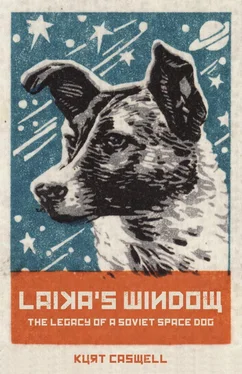The orb-weaver is a hardy spider that can live for up to three weeks without food, as long as it gets plenty of water. It bears a distinct pattern of mottled white over its abdomen that looks a bit like a cross, hence it is sometimes called a cross spider. The female is larger than the male, and as these things sometimes go, she will eat him just after mating. She bites him, wraps him in her white silk, waits. When he is dead, she liquefies his body with her vomit and then consumes him. She will consume her web too, daily, the sticky part where her prey is caught and rendered, and then spin another to await the next good catch. She hangs head-down in the center of the web or hides in nearby foliage with one of her clawed legs resting on a signal line, and when that line jitters, she kills and feeds.
A crew of three men flew with Arabella and Anita: commander Alan Bean (who also flew on Apollo 12 ), science pilot Owen Garriott, and pilot Jack Lousma. Before launch, Arabella and Anita were fed houseflies (lucky for the men on board) and given a sponge saturated with water. They launched on July 28, 1973, for a fifty-nine-day mission.
On August 5 Arabella was released into a lighted box where she would have the space to spin her web. Back on Earth, another orb-weaver was released into the same kind of box as a control experiment. When Garriott opened the vial, Arabella would not come out. Garriott waited for a time and then gave the vial a good shake. Out came Arabella into the box, floating away in microgravity, her legs furiously pumping as she drifted, until she hit the wall of the box, reached out, and grabbed on. Garriott would record the events with video and still cameras.
During that first day, all Arabella could produce was a little punk of a web in the corner of the box. The next day, however, she finished it, but it was crudely constructed, inexact and unkempt, with lines diving off in various directions. The strands themselves were spun at various thicknesses, and were mostly thinner, weaker strands. On Earth, a spider can vary strand thickness to meet the needs of its own body weight, but the strands are usually uniform in the spinning of a single web. Here in space, without gravity, Arabella had trouble sensing how much she weighed, so in her confusion she attempted a number of different sized strands. The main point was that the web held together, and there she was, Arabella in her space web, the first in the history of the world.
On August 13 Garriott destroyed Arabella’s web to see if she would remake it and if the new web might not be better constructed. But she didn’t remake it. She hung on the side of the box doing nearly nothing. Garriott decided to feed and water both spiders—Arabella in the box, Anita still in her holding vial. He replenished the water in the sponges and then fed the spiders a bit of filet mignon, cooked rare, meat scraps from the astronauts’ supper. Arabella extracted juices from the meat and then kicked the dried thing out of her web as she would a desiccated fly. Thus fortified, she went to work again, and this time she constructed a very nice, geometrically balanced web. It had taken her several days to adjust to microgravity, Garriott decided, but once she did, microgravity was no longer a deterrent to good web-building. In his evaluation of the experiment, Witt and his co-authors arrived at a similar conclusion: “There is a transition time during which spiders gradually acquire the skill to move ‘competently’ under weightless conditions.”
After about three weeks of web spinning, Arabella was shuttled back into her vial, and Anita was released into the box. The results were pretty near the same. Anita’s first efforts were feeble, and after a couple of days and a couple of tries she got the hang of it. She began to spin lovely little webs in space. “It is probably the absence of body weight which disturbed each of the two animals severely during the first days after release from the vial,” Witt and his co-authors write. Then on September 16, Garriott found Anita dead in the box. He collected her body and returned it to the vial. She would return to Earth with the crew for further examination.
The crew splashed down in the Pacific on September 25, and now back on Earth they found Arabella dead too, likely from starvation. It was a long way to go for two spiders. During their flight, Arabella and Anita got a lot of press, their story and pictures in newspapers and on TV. They were famous spiders now, despite the fact that they were dead, and so their curled, dead bodies joined the permanent collection at the Smithsonian. The most interesting finding, write Witt and his co-authors, has little to do with observations about the nervous system but with “the ability of an invertebrate animal with as rigid a behavior pattern as orb-web construction which is relatively independent of experience to find alternate ways to complete a perfect trap for food and thereby increase its chance for survival.”
¤
In 2007 the European Space Agency sent a community of tardigrades, also known as the water bear, into the vacuum of space on the Foton-M3 mission. The water bear is a microscopic invertebrate animal left over from the Cretaceous, and likely even further back, which means it has been around for at least 250 million years. Under a microscope it does look like a little bear, with a barrel-like body, eight little bear legs with claws, and a snout-like mouth used to pierce the cells of the tiny plants, algae, and invertebrates that it eats. On Earth, the water bear is found almost everywhere. It flourishes in mosses and marshes where conditions are generally warm and moist. It has also been found in the most extreme environments: under crushing pressure at ocean depths, at dizzyingly low pressure at mountain heights, in roiling hot springs, and on barren ice shelves. It lives in the wet, warm tropics and in dry, sandy deserts. Nearly unkillable, it is one of the hardiest animals on Earth.
After ten days of exposure to space on the Foton-M3 , the water bears returned to Earth alive. A human being exposed to space without protection has about 30 to 90 seconds to live, and up to 180 seconds for Chuck Norris. It’s not just the absence of breathable air that is the problem. It’s also temperature extremes, the absence of atmospheric pressure (vacuum), and radiation. The water bear withstood all of this for ten days. It managed temperature ranges from -272.8 degrees Celsius (three times colder than the coldest temperature ever recorded on Earth) to 151 degrees Celsius (hot enough to bake bread or slow roast a chicken). The vacuum of space had almost no negative effects on the water bear. And it withstood cosmic radiation at a level 1,000 times greater than what we experience here on Earth. The UV radiation from our sun is also over 1,000 times greater in space than here on Earth, and it fries cellular structures and DNA. At this intensity a number of water bears did die, but a number also survived.
How does the water bear do it? The water bear does it by dropping into a dormant state. It reduces the moisture content in its body to as low as 3 percent and hardens the membranes of its cells. In effect, it creates its own protective shell called a tun, a little spacecraft if you will, inside which it waits for conditions to improve. Caspar Henderson writes in his fantastic book The Book of Barely Imagined Beings that on Earth the water bear can remain in this state for 120 years. When conditions improve, the water bear rehydrates itself and goes about its business, a “micro, aqueous Phoenix,” Henderson calls it, rising up from the dead.
There is something even more curious going on here too. In 2015 a team of scientists from the University of North Carolina at Chapel Hill announced that they had successfully sequenced the genome of the water bear. What they discovered is that upward of 17.5 percent of the water bear’s genes are not water bear genes. They come from other species, from bacteria, plants, fungi, and various microbes. Until now, it was thought that such gene borrowing occurred at a much lesser rate among Earth species. The rotifer was the previous champ at 8 to 9 percent, while most animals will carry only about 1 percent foreign DNA. The water bear accomplishes its feat through horizontal gene transfer as opposed to sexual reproduction. As it is coming out of its dormant state and reconstituting its body with water, its cell membranes are porous, even leaky, allowing foreign DNA and other molecules to enter. Some of these foreign bodies may be of no help at all and may even cause death. But some of them work to the water bear’s advantage. Natural selection takes care of the rest, and 250 million years later we have an animal that really is as tough as Superman. It may be that the water bear’s ability to withstand extreme environments is based on the acquisition of these foreign DNA, just as the process of moving into and out of its dormant state to withstand these extreme environments allows the acquisition to occur.
Читать дальше












